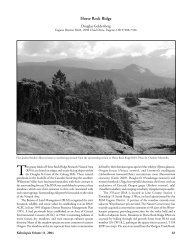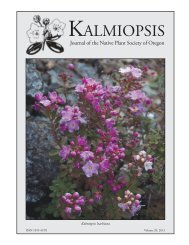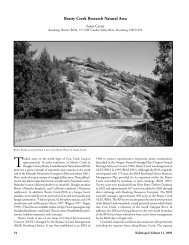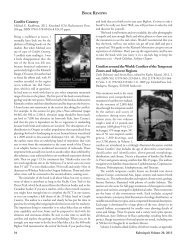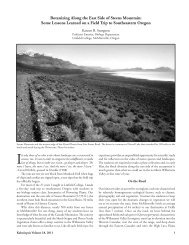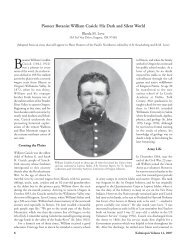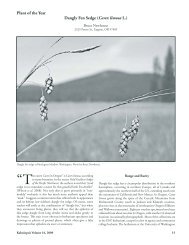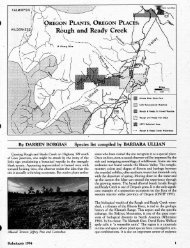Henderson's Checkermallow - Native Plant Society of Oregon
Henderson's Checkermallow - Native Plant Society of Oregon
Henderson's Checkermallow - Native Plant Society of Oregon
Create successful ePaper yourself
Turn your PDF publications into a flip-book with our unique Google optimized e-Paper software.
Hitchcock. In 1883, the well-known Pennsylvania botanist Thomas<br />
Meehan found the checkermallow near Victoria on Vancouver<br />
Island; his specimen can be seen at the Academy <strong>of</strong> Natural Sciences<br />
in Philadelphia. Meehan called his specimen “S. malvaeflora” but<br />
his label reveals that he had his doubts about the identification.<br />
Eva Roush recognized the specimen as S. hendersonii in 1931.<br />
Henderson’s checkermallow did not gain its recognized scientific<br />
name until 1887, when two <strong>Oregon</strong> pioneer botanists collected it<br />
almost concurrently. Although Louis F. Henderson and Thomas<br />
Jefferson Howell <strong>of</strong>ten worked together, their respective discoveries<br />
<strong>of</strong> this species were made independently. Howell’s collection on<br />
June 15 th at the mouth <strong>of</strong> the Umpqua River was the first in <strong>Oregon</strong>.<br />
He labeled it “Sidalcea campestris.” Two weeks later (July 3 rd ),<br />
Henderson encountered it in the Columbia River estuary, at a location<br />
he identified as “near Clatsop Bay.” This site does not appear<br />
on maps but “Clatsop Beach” is indicated on an early map in the<br />
vicinity <strong>of</strong> Fort Stevens State Park near present day Hammond. Both<br />
Howell and Henderson sent their specimens to Harvard, where the<br />
Howell specimen was apparently overlooked for a number <strong>of</strong> years,<br />
while Henderson’s was named for the collector by Sereno Watson.<br />
Both collections can be studied at the Gray Herbarium today.<br />
Other early collectors <strong>of</strong> Sidalcea hendersonii in <strong>Oregon</strong> included<br />
Morton E. Peck <strong>of</strong> Willamette University who found it at Nestucca<br />
Spit in 1909, and at Sand Lake and Cannon Beach in 1924. LeRoy<br />
Abrams <strong>of</strong> Stanford collected it at Seaside in 1922, and Henderson<br />
collected it two more times, first at Cannon Beach in 1929 and<br />
again at Florence in 1931. C. L. Hitchcock <strong>of</strong> the University <strong>of</strong><br />
Washington made a collection north <strong>of</strong> Reedsport in 1951.<br />
Holotype <strong>of</strong> Sicalcea hendersonii collected by Louis F. Henderson “near Clatsop Bay, <strong>Oregon</strong>” on<br />
July 3, 1887. Note annotations by Eva M. F. Roush, and C. L. Hitchcock. Courtesy <strong>of</strong> the Gray<br />
Herbarium, Harvard University.<br />
Sidalcea Origins and Taxonomy<br />
The genus Sidalcea A. Gray (Malvaceae)<br />
comprises annual and perennial herbs<br />
inhabiting western North America from the<br />
Rocky Mountains west to the Pacific coast,<br />
and from Mexico north to British<br />
Columbia. Although Eva Roush (1931)<br />
suggested that Sidalcea originated in Mexico<br />
and spread northward, recent molecular<br />
studies do not completely support this<br />
theory (e.g. Andreason and Baldwin 2003).<br />
Steven R. Hill, author <strong>of</strong> the treatment for<br />
Malvaceae in The Jepson Manual (Hickman<br />
1993), has studied phytogeographic<br />
evidence for Sidalcea and proposes that a<br />
California-Sierran origin is more likely<br />
(Hill, pers. comm.). Floras recognize at least<br />
18 species in California (Hickman 1993),<br />
13 species in <strong>Oregon</strong>, and 3 species in<br />
Washington (Hitchcock et al. 1961), and 2<br />
species are known from Mexico (Fryxell<br />
1998). Among checkermallow species,<br />
Sidalcea hendersonii has the most northerly<br />
distribution, with several populations<br />
scattered up the British Columbia coastline<br />
and a single occurrence discovered in 2003<br />
near Juneau, Alaska. The latter represents<br />
the first record <strong>of</strong> Malvaceae in Alaska’s<br />
diverse native flora. A conspicuously tall<br />
plant, Henderson’s checkermallow reaches<br />
nearly 5 feet in height, and is distinguished<br />
from other checkermallows primarily by its<br />
habitat and by its glabrous foliage and<br />
smooth carpels. Henderson’s checkermallow<br />
is found only in tidally influenced areas<br />
where fresh water from lakes or streams<br />
meets salt water <strong>of</strong> the Pacific Ocean. Some<br />
<strong>of</strong> its salt marsh-adapted associates include<br />
Pacific silverweed (Argentina egedii ssp. egedii,<br />
syn. Potentilla anserina ssp. pacifica), western<br />
yarrow (Achillea millefolium), seacoast<br />
angelica (Angelica lucida), and tufted hairgrass<br />
(Deschampsia caespitosa). No other<br />
2 Kalmiopsis Volume 12, 2005



